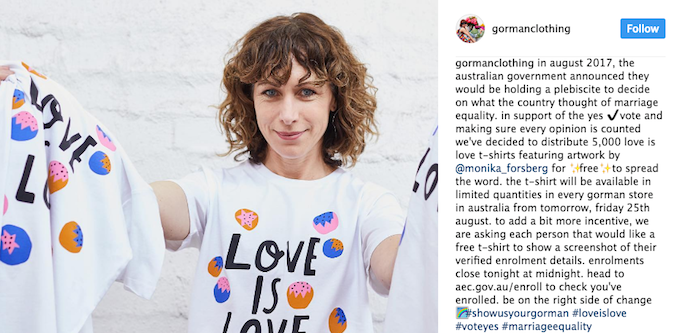
Source: Instagram
Australian fashion retailer Gorman has captured the attention of tens of thousands of shoppers on social media after pledging to give away 5000 free limited edition t-shirts this morning as part a campaign for marriage equality.
The cult-favourite label has been posting a variety of “Love is Love”-themed illustrations this week, and yesterday announced it would be giving away the t-shirts to shoppers who came into stores and proved they had updated their electoral roll records ahead of the national postal vote on same-sex marriage in Australia.
Telling shoppers to “get in early”, the brand also encouraged customers to share images of the shirts and their support of a change to marriage laws on social media, using the hashtag #showusyourgorman.
Before shops were even open on Friday morning, fans and other retail brands were talking about the campaign on social media.
Competition for the shirts has reportedly been fierce, with some customers complaining stock was all gone from stores by just after 9:00am this morning.
Gorman has created social media campaigns around other social issues in the past, but not all have been successful. In 2016, the label was hit with criticism after posting an image of a factory worker holding a sign saying, “I make your clothes”, which many called “tokenistic” in light of concerns around the conditions of garment factory workers.
Whether or not local brands should be weighing in on marriage equality has been a topic of contention over the past few months, with companies of all sizes making a choice to speak out on the issue.
Some public displays have divided customers, like a flash-mob launched by lingerie brand Honey Birdette two weeks ago that had some calling out the attempt as a marketing campaign.
However, this week’s campaign from Gorman is likely to be successful because it has accurately taken the online pulse of the brand’s social media community, says director of CP Communications Catriona Pollard.
“In any of these kind of social statement campaigns, you have to have a really, really confident understanding about how your community will react,” she says.
“In this case, it’s a really clever tactic.”
Three steps to “newsjacking” that will work for your business
Pollard says the Gorman campaign has a number of elements that smaller businesses can employ when thinking about their own issues-based campaigns.
Firstly, using social media as the starting point is a good approach, because it allows you to make sure any statement you make will resonate with customers.
“If a business has a good understanding of this, [and] are facilitating and showing they agree with their community’s sentiments, then it generates a massive amount of goodwill,” she says.
Gorman has a strong social media base to draw from on this front, with 171,000 Instagram followers and 155,000 Facebook fans, as well as an unofficial Facebook group dedicated to buying and selling second-hand products, which has more than 6000 members.
But this connection is only part of the strategy, Pollard says.
The second step is to decide who a campaign will actually target — in this case, the “Love is Love” shirts are designed to connect with both new and existing customers.
“If you’ve never bought Gorman before but you’re aware of that brand, then this idea and news of a free item is going to drive you in store,” Pollard observes.
For SMEs looking to get a viral response to a campaign, achieving widespread reach is more difficult, she says. However, the third element of the Gorman campaign contains an important lesson: have a social media-focused idea that has a real-life call to action.
“Think about what’s going to trigger your customer to take action: to share it and to come into the store and purchase from you. Here, they’ve got them to take action online, then come into store, and then you’ll potentially buy something,” Pollard says.
For small businesses looking to speak out on social issues they feel strongly about, the most important part of the process is deciding what you want to get out of it, says Pollard.
“How is it going to impact the business? Is it going to create goodwill, foot traffic, what? There does have to be an end goal for it.”
SmartCompany contacted Gorman for comment but did not receive a response prior to publication.
Never miss a story: sign up to SmartCompany’s free daily newsletter and find our best stories on Twitter, Facebook, LinkedIn and Instagram.


COMMENTS
SmartCompany is committed to hosting lively discussions. Help us keep the conversation useful, interesting and welcoming. We aim to publish comments quickly in the interest of promoting robust conversation, but we’re a small team and we deploy filters to protect against legal risk. Occasionally your comment may be held up while it is being reviewed, but we’re working as fast as we can to keep the conversation rolling.
The SmartCompany comment section is members-only content. Please subscribe to leave a comment.
The SmartCompany comment section is members-only content. Please login to leave a comment.